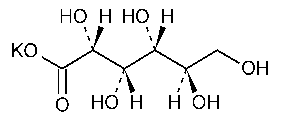Potassium Gluconate
D-Gluconic acid,monopotassium salt.
Monopotassium D-gluconate [299-27-4].
Monohydrate 252.26 [35398-15-3].
»Potassium Gluconate is anhydrous or contains one molecule of water of hydration.It contains not less than 97.0percent and not more than 103.0percent of C6H11KO7,calculated on the dried basis.
Packaging and storage—
Preserve in tight containers.
Labeling—
Label it to indicate whether it is anhydrous or the monohydrate.
Identification—
A:
Infrared Absorption á197Mñ.
B:
It responds to the flame test for Potassium á191ñ.
Loss on drying á731ñ—
Dry it in vacuum at 105 for 4hours:the anhydrous form loses not more than 3.0%of its weight,and the monohydrate loses between 6.0%and 7.5%of its weight.
for 4hours:the anhydrous form loses not more than 3.0%of its weight,and the monohydrate loses between 6.0%and 7.5%of its weight.
Heavy metals,Method Iá231ñ—
Dissolve 1g in 10mLof water,add 6mLof 3Nhydrochloric acid,and dilute with water to 25mL:the limit is 0.002%.
Reducing substances—
Transfer 1.0g to a 250-mLconical flask,dissolve in 10mLof water,and add 25mLof alkaline cupric citrate TS.Cover the flask,boil gently for 5minutes,accurately timed,and cool rapidly to room temperature.Add 25mLof 0.6Nacetic acid,10.0mLof 0.1Niodine VS,and 10mLof 3Nhydrochloric acid,and titrate with 0.1Nsodium thiosulfate VS,adding 3mLof starch TSas the endpoint is approached.Perform a blank determination,omitting the specimen,and note the difference in volumes required.Each mLof the difference in volume of 0.1Nsodium thiosulfate consumed is equivalent to 2.7mg of reducing substances (as dextrose):the limit is 1.0%.
Organic volatile impurities,Method Iá467ñ:
meets the requirements.
Assay—
Potassium stock solution—
Dissolve 190.7mg of potassium chloride,previously dried at 105 for 2hours,in water.Transfer to a 1000-mLvolumetric flask,dilute with water to volume,and mix.Transfer 100.0mLof this solution to a 1000-mLvolumetric flask,dilute with water to volume,and mix.This solution contains 10µg of potassium (equivalent to 19.07µg of potassium chloride)per mL.
for 2hours,in water.Transfer to a 1000-mLvolumetric flask,dilute with water to volume,and mix.Transfer 100.0mLof this solution to a 1000-mLvolumetric flask,dilute with water to volume,and mix.This solution contains 10µg of potassium (equivalent to 19.07µg of potassium chloride)per mL.
Standard preparations—
To separate 100-mLvolumetric flasks transfer 10.0,15.0,and 20.0mL,respectively,of Potassium stock solution.To each flask add 2.0mLof sodium chloride solution (1in 5)and 1.0mLof hydrochloric acid,dilute with water to volume,and mix.The Standard preparationscontain,respectively,1.0,1.5,and 2.0µg of potassium per mL.
Assay preparation—
Transfer about 180mg of Potassium Gluconate,accurately weighed,to a 1000-mLvolumetric flask,add water to volume,and mix.Filter a portion of the solution.Transfer 5.0mLof the filtrate to a 100-mLvolumetric flask,add 2.0mLof sodium chloride solution (1in 5)and 1.0mLof hydrochloric acid,dilute with water to volume,and mix.
Procedure—
Concomitantly determine the absorbances of the Standard preparationsand the Assay preparationat the potassium emission line of 766.5nm,with a suitable atomic absorption spectrophotometer (see Spectrophotometry and Light-scattering á851ñ)equipped with a potassium hollow-cathode lamp and an air–acetylene flame,using water as the blank.Plot the absorbance of the Standard preparationversus concentration,in µg per mL,of potassium,and draw the straight line best fitting the three plotted points.From the graph so obtained,determine the concentration,in µg per mL,of potassium in the Assay preparation.Calculate the weight,in mg,of C6H11KO7in the Potassium Gluconate taken by the formula:
20C(234.25/39.10),
in which Cis the concentration,in µg per mL,of potassium in the Assay preparation,234.25is the molecular weight of potassium gluconate,and 39.10is the atomic weight of potassium.
Auxiliary Information—
Staff Liaison:Lawrence Evans,III,Ph.D.,Scientist
Expert Committee:(DSN)Dietary Supplements:Non-Botanicals
USP28–NF23Page 1591
Phone Number:1-301-816-8389
